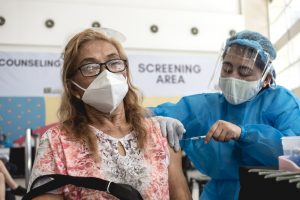The COVID-19 situation in the Philippines continues to worsen, with daily infections extending to new peaks as the Omicron runs rampant through the densely populated Metro Manila region.
On January 15, the country registered a new daily record of 39,004 infections, which was the fifth daily record to be registered in less than a month. This was followed by more than 37,000 COVID-19 infections on both Sunday and Monday, which brought the country’s total to more than 3.2 million, in addition to 52,929 deaths from the virus.
For the past few weeks, Philippine health officials have assumed that the new and sudden spike in cases is being driven by the fast-spreading Omicron variant of COVID-19, something that was confirmed by health officials on January 15.
The current outbreak, which began after the Christmas and New Year holiday period, is placing an additional strain on healthcare infrastructure in the capital region, an agglomeration that is home to some 13 million people. According to The Inquirer, 55 percent of the beds in the city’s intensive care units are now occupied, along with 52 percent of isolation beds, 69 percent of ward beds, and 26 percent of ventilators.
The government has responded by hiking the COVID-19 alert for Metro Manila and imposed a “no vax no ride” policy on the capital’s public transport system, including public jeepneys, taxis, buses, sea ferries, and commercial flights. (After a public outcry, the government has since exempted workers from the policy.)
As I suggested last week, officials are now also taking seriously the possibility of the virus interacting in damaging ways with the Philippine presidential election on May 9. Only 49.7 percent of the country’s population of 110 million has been fully vaccinated, raising the risk that crowded rallies and campaign events could further spread the virus.
Dr. Teodoro Herbosa, a medical adviser to the government’s COVID-19 task force, said in an interview with Reuters this week that the government must bring down COVID-19 cases by April to ensure the election does not become a “superspreader” event. “(It is) very important that we are able to tame this virus before May 9,” he said.
To prevent the election from acting as a potent vector for COVID-19, or to prevent COVID-19 from disrupting the fair conduct of the election, the government has announced plans to begin distributing vaccine booster shots in pharmacies in the National Capital Region (NCR) on January 21. Today, a presidential spokesperson said that the government was aiming to fully vaccinate the rest of the country’s adult population by Election Day.
In its race to Election Day, the government could well be aided by the unique characteristics of the Omicron variant, which spreads more quickly than previous strains, but is believed to produce fewer instances of severe illness. According to a report in the New York Times, health officials are reporting that recent infections are different than those seen in previous waves: infections are less severe, and people are making faster recoveries, allowing the government to tweak its response to the virus accordingly.
Last weekend, Health Undersecretary Maria Rosario Vergeire told a public briefing that the country’s new high-pitched wave of infections may peak sometime from the end of this month to the middle of next. With the formal campaign period set to begin on February 8, however, the Philippine government has a narrow window to get things right.

































